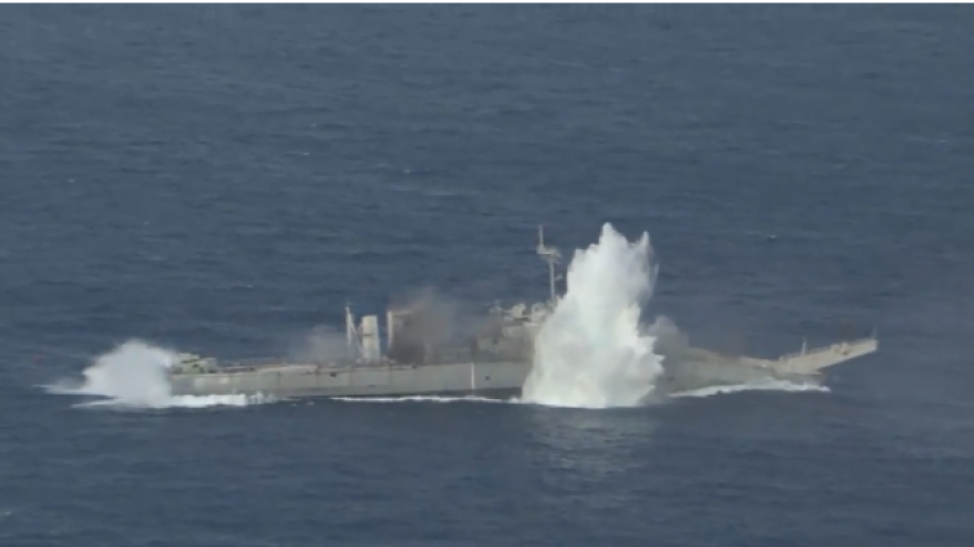Water Wars: China Crashes the Party at the Rim of the Pacific Exercises
The 26th biennial Rim of the Pacific naval military exercises, the largest international maritime exercises in the world, kicked off in and around Hawaii on June 27 with one participant notably absent. The U.S. military chose to disinvite China this year due to its “continued militarization of disputed features in the South China Sea,” Pentagon spokesman Marine Lt. Col.

Published by The Lawfare Institute
in Cooperation With

The 26th biennial Rim of the Pacific naval military exercises, the largest international maritime exercises in the world, kicked off in and around Hawaii on June 27 with one participant notably absent. The U.S. military chose to disinvite China this year due to its “continued militarization of disputed features in the South China Sea,” Pentagon spokesman Marine Lt. Col. Christopher Logan told reporters in May.
In a joint press conference in May with Secretary of State Mike Pompeo, Chinese Foreign Minister Wang Yi called the decision to disinvite China “non-constructive,” saying it was “unhelpful to mutual understanding between China and the U.S.”
This statement did not entirely prevent China from showing up. As it has for the past two exercises, China deployed a People’s Liberation Army Navy (PLAN) Type 815 Dongdiao-class spy vessel to observe the maneuvers. A Pacific Fleet spokesman, Capt. Charlie Brown, stated that the Navy did not believe the spy vessel was disrupting the exercises, and in the past, the United States has allowed similar surveillance activities, which are allowed under international law.
Aside from the Chinese surveillance, the exercises were particularly notable for their focus on interoperability. Australia, Japan and the United States cooperated on two “SINKEX” training events, using coordinated live fire to sink two decommissioned target vessels, the USS Racine and USS McClusky.
Speakers for the respective navies emphasized that these exercises signals a “series of firsts” for the navies, including the first time Japan has conduct live-fire missile testing in Hawaii, and the first time Japan and the United States have conducted a SINKEX together.
These missile exercises could also help train these militaries to operate in the South China Sea. The U.S. and Japan used ground forces instead of ships to conduct the exercise, which accords with the concept of “archipelagic defense”—the practice of using ground forces stationed on islands to control the surrounding airspace and sea-lanes. Such a strategy could complicate China’s ability to exert maritime influence if Japan, the U.S. or other countries decided to directly challenge Beijing in the South China Sea.
In total, over 25,000 naval personnel and 52 ships from 26 countries are participating in the exercises, which will run until Aug. 2. In addition to the live-fire missile exercises, participating countries will be conducting training exercises in a variety of areas including disaster relief, anti-piracy operations, mine clearance, ground combat and air defense.
In other News
The Philippines
In his State of the Nation Address on July 23, President Rodrigo Duterte of the Philippines promised to “defend our interest in the West Philippine Sea,” the first time he has taken such an explicitly hard line against Chinese encroachment.
Duterte has taken a more China-friendly stance than previous Philippine governments, accepting significant levels of Chinese investment and assistance while declining to enforce the Philippine’s victory in the 2016 arbitration case before the U.N. maritime law tribunal, which had held that China was illegally claiming islands and sea territory in the South China Sea. However, a recent poll found that 73 percent of the Philippine population want the government to assert its rights in the South China Sea, while only 20 percent wanted the government to “continue befriending China” despite the dispute.
Both China and the Philippines claim multiple features in the South China Sea, including the Scarborough Shoal and Spratly archipelago.
The Philippines government is also in the process of proposing a new Constitution, and the drafting committee recently confirmed that the new Constitution will include language asserting that the Philippines has sovereignty over islands and features beyond its archipelago in accordance with international law, referencing the tribunal’s decision.
But the draft Constitution has also drawn significant criticism for granting the presidency sweeping powers to make unilateral decrees, though the Duterte administration has stated it does not want the Constitution to go into effect until the next president takes office.
Sri Lanka
A recent analysis from the New York Times delves into the details of how China forced Sri Lanka to hand over the Hambantona Port Development Project, strategically located a few hundred miles off the coast of India, in an example of what some critics of China have called a “debt trap”
As part of the Belt and Road Initiative, the Chinese government bank had financed the port with loans totaling approximately $1 billion, on the condition that it be built by the China Harbor Engineering Company, a Chinese firm. When the port proved to bring in almost no revenue (drawing only 34 ships in 2012, for example), China renegotiated a deal with the Sri Lankan government for a 99-year lease on the port and its surrounding area in exchange for debt relief.
The port’s financing exhibited significant evidence of corruption. Former Sri Lankan President Mahinda Rajapaksa championed the project despite feasibility studies from his own government indicating it was not economically viable. President Rajapaksa also received at least $7 million of campaign funds from the Chinese construction company. When Rajapaksa lost a bid for reelection in 2012, the new government decided to sign over the port as part of its efforts to reduce the country’s debt load.
Though the terms of the agreement bar China from using it for military purposes, India has raised concerns in the past over China’s ability to exert strategic influence on Sri Lanka. For example, in 2014 China docked a submarine and warship in Sri Lanka at the same time that Japanese Prime Minister Shinzo Abe was visiting the country.
A spokesman for the Chinese Foreign Ministry, Lu Kang, denied that China had taken over the port through any kind of “debt trap,” saying that the handover of the port was the result of “commercial cooperation that favors both sides” and arguing that the Times’s analysis displayed irresponsibility or ulterior motives.
Analysis and Commentary
In the East Asia Forum, Samut Ganguly analyzes India’s decision not to invite Australia to participate in its 2018 Malabar naval military exercises, saying that India likely did so in order to avoid provoking China. However, Ganguly, noting India’s continued participation in the Quadrilateral Security Dialogue with the Australia, Japan and the U.S. also concludes that India is trying to steer a “middle course” between irritating China while still maintaining freedom of navigation.
In the Sydney Morning Herald, Peter Hartcher reports on a prediction made by Peter Jennings, director of the Australian Strategic Policy Institute, that within a year China will close off freedom of navigation in the South China Sea for the purposes of military exercises. In analyzing this prediction, Hartcher questions whether the United States will be able to challenge China if it decides to take such an unprecedented step in asserting sovereignty over the region.
And Muhamad Arif in the Asia & Pacific Policy Forum discusses the failure of Indonesia’s new Maritime Security Agency to end infighting and redundancy between Indonesia’s maritime agencies. Noting that the Indonesian Navy is used to assuming a dominant role, and that new agency has not been acting as the leading actor in maritime security, Arif calls for a “new consensus” on how to coordinate these efforts.
Water Wars is our monthly roundup of the latest news, analysis, and opinions related to ongoing tensions in the South and East China Seas. Please email Nathan Swire with breaking news, relevant documents, or corrections.





